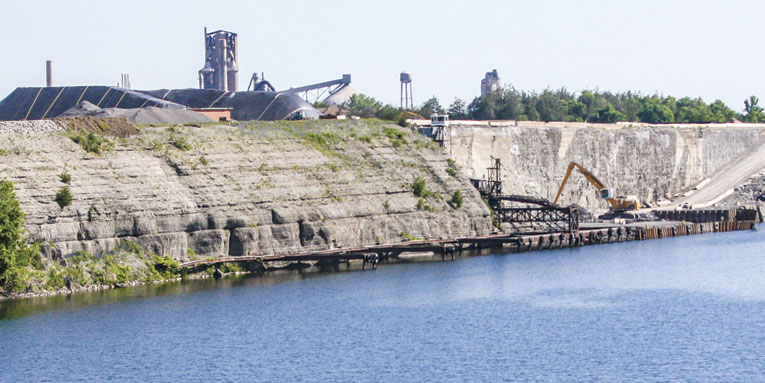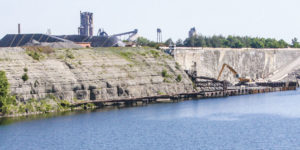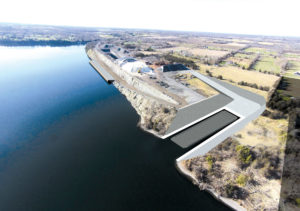County News
Port in a storm

Picton Bay neighbours voice concerns about scale of Picton Terminals’ ambitions
The resurrection of the former Bethlehem Steel docks in Picton Bay began arousing concerns when the developer, Picton Terminals, a company controlled by the Doornekamp family from Odessa, began blasting away the cliff face to enable truck and loading equipment to descend to the water’s edge. Many tonnes of rock were blasted—sending dust across the bay— excavated and subsequently piled along the back of property on White Chapel Road, to facilitate off-loading of steel, aggregates and other material from ships using the port. Eight ships have visited the port since it opened for business in September.
Neighbours around the bay are accustomed to shipping traffic, as the laker ship, the Stephen B. Roman, visits nearby Essroc regularly. Most could tolerate a few more ships each year and so kept their concerns somewhat to themselves. Few wanted to interfere with scarce industrial investment in Prince Edward County.
But as the ambitions for Picton Terminals grow and expand, so too do the worries about what it means for the safety of Picton’s drinking water, the environment and the quiet enjoyment of life for residents on Picton Bay.
Ben Doornekamp believes some of the concerns have been overstated—but in any event, Picton Terminals is working closely with all regulatory agencies and the municipality to ensure the safety of the water supply and the health of Picton Bay and the environment. Further, he says the port facility has modified its plans in an attempt to mitigate the neighbours’ concerns.

Picton Terminals has cancelled plans to blast the cliff face to the left of the ship loader in the middle of this photograph. The facility has modified its plans, in part, to accommodate concerns of neigbhours living on Picton Bay. Those earlier plans would have seen Picton Terminals extend the blasting and excavating to the treeline at left in this photograph.
BIGGER SHIPS
Among the chief worries of those living nearby is the scale of the ships visiting Picton Terminals. Most are accustomed to seeing the Stephen B. Roman arrive at the Essroc dock. It is a 149- metre ship that carries a maximum of 6,792 tonnes of cement and has never left the Great Lakes. The Federal Caribou delivered a load of steel to Picton Terminals in April. The ship, delivering cargo from Korea, stretches 220 metres and is built to carry nearly three times more material than the Stephen B. Roman. Picton Bay residents worry about what these foreign ships are bringing into the fragile bay—upon which the entire town depends for drinking water.
Some of the ocean-going freighters visiting Picton draught more than eight metres—offering scarcely little clearance from the bottom of Picton Bay. Some boaters have reported terrible odours and thick dark water in the wake of these large vessels.
“It looked like pea soup, and we had to cover our noses and mouths to prevent gagging from the smell,” said one sailor.
The Stephen B. Roman draughts 4.4 metres by comparison. Picton Bay, south of the cement plant, ranges in depth from 4.6 metres to 9.7 metres, according to the County’s water intake replacement study produced in 2014. The average depth in front of Picton Terminals is about 8 metres.
Doornekamp says Fisheries and Oceans Canada (DFO) has assessed the bay and given Picton Terminals the green light.
The Picton water intake study points to the existence of mercury and heavy metals in the sediment in Picton Bay—with mercury levels exceeding federal guidelines. All possible new intake locations have similar heavy metal concentrations and exceedances, according to the report’s authors.
Quoting the study, “There was no one particular location that stood out as the preferred location based on the sediment sampling data.” The full study is available by clicking here.
Still, the Picton Bay neighbours might have been willing to live with this intrusion—especially since neither Quinte Conservation, the municipality nor Ministry of the Environment and Climate Change had raised a warning flag.
EXPANSION PLANS
That is, until they learned that Picton Terminals had big plans to expand the port, blast away much more cliff face, construct a massive barge offloading facility and attract as many as 100 of these large ships each year into the shallow bay.
Ben Doornekamp says Picton Terminals has changed its plans to accommodate neighbours’ concerns.
“We will not be doing any drilling and blasting on the west side of the ship loader as previously planned,” said Doornekamp. “As part of this scope reduction, the dock infill will now only be going to the ship loader as well, which will be about 10 per cent more work than we have done to this point on the infill.”
He added that a new barge facility is currently subject to approval by Quinte Conservation and DFO.
The scale of the Doornekamps’ plans began to emerge in May when they came to a council committee meeting seeking support for a request for $10 million from the provincial and federal governments to purchase two large cranes for the port.

Artist rendering of Picton Terminal’s plan for a new barge loading/offloading facility.
VOICING CONCERN
Victor Lind lives on Picton Bay.
“I am not a NIMBY [not in my back yard],” Lind told a meeting of the Community and Economic Development Committee earlier this month. “I was in favour of the original plan. But this is a matter of scale.”
He notes that the municipality plans to relocate Picton’s water supply farther into the bay—directly under the path of incoming ships. He worries about dozens of ships churning up the bay bottom as they arrive each year.
The estimated cost to move Picton’s intake farther out into Picton Bay, according to the 2014 study, ranges from $6.8 million to $9.4 million.
“Will this force the County to get Picton’s water from Wellington?” asked Lind of the council members present. “The cost of that plan is $25 million, many times the cost of moving the intake pipe into the bay. Who is going to pay for this?”
Others want to know where the benefit is for Prince Edward County. Ben Doornekamp says Picton Terminals will remove truck traffic from Highway 401 as well as provide transportation savings for regional industry and agriculture. But David McKay doesn’t see how it helps to overload County Road 49 with thousands of trucks each year—a road already labelled as the “worst in Ontario.”
“What do the residents of Prince Edward County gain?” asks McKay. “We need to know this to understand why we must sacrifice our health, safety and property values.”
Mayor Quaiff says this is an instance where County residents must take a larger view.
“I think the vision has to include Eastern Ontario and not just focus on PEC,” said Quaiff. “There is full support of the Eastern Ontario Wardens’ Caucus, Eastern Ontario Mayors’ Caucus, both federal and provincial governments, our municipality, along with several other municipalities in the east region.”
He says these governments and organizations back the Picton Terminals expansion because it represents improved efficiency to the manufacturing, industrial and agriculture sectors of the eastern Ontario economy. He points, too, to a reduced reliance on truck transportation—a leading contributor to greenhouse gas emissions in the province.
MORE STUDY
Larry Richardson was astonished that council supported the Doornekamps’ request without first investigating the implications of a large-scale expansion of Picton Terminals on the town’s drinking water, the County’s tourism economy and Highway 49.
Lind notes, too, that the property is zoned as Extractive Industrial, which he believes is inappropriate for a port facility, as it is not a quarry, pit or aggregate processing plant.
“Why is our mayor pursuing this so vigorously?” said Lind.
Mayor Robert Quaiff says each of the concerns raised will be answered as part of a site plan agreement for the port expansion.
“Various levels of government will provide input including Quinte Conservation, the Ministry of Natural Resources and Forestry, the Ministry of the Environment and Climate Change, the DFO and the municipality,” said Quaiff. I believe at the end of the day most concerns can be properly addressed.”
Meanwhile, Ben Doornekamp suggests that improvements to County Road 49 are linked to Picton Terminals’ expansion.
“Mayor Quaiff is working to leverage our funding model to gain funding to for County Road 49 from the province and feds to rebuild without requiring local tax dollars,” said Doornekamp. “We are supporting his plan. It’s not one or the other; it’s both or nothing. Also, based on current traffic projections, we anticipate increasing traffic by less than one per cent on County Road 49.”
Concerning zoning, Doornekamp says the property was reclassified by mistake when the County produced the Comprehensive Zoning By-Law in 2006— combining the zoning rules of 10 wards into one bylaw. He says his company is spending more than $150,000 to restore the original zoning as a port.
“It has never stopped being used as a port,” said Doornekamp.

100 ships = how many thousands of gallons of untreated ballet water??
May as well screw up the water even more, after all the Asian carp will be here in no time.
Save the air(greenhouse gas) and pollute the water… good thinking!
The terminal has been in continous use since it opened nearly 70 years ago.
It is unbelievable that our Mayor, our Councillors and Mr. Doorekamp agree that this blight on The County can have any beneficial effect . Living on County Rd. 49 has been become much less pleasant due to the major increase in the speeding 18 wheeler transports serving Port Picton. At least our Mayor acknowledges that the highway is in a very poor state. How observant of him. Do he and our Councillors believe that a huge increase in heavy truck traffic will be an asset to The County ?
There has been no environmental impact study completed for the Port Picton development and the risk of our water being contaminated is obvious. Big ships….a possible 100 a year…..require ballast water. We are
all very aware of the results of contaminated ballast water being dumped. Think Zebra Mussels….think tourism decline. Think noise pollution…think unsightly scars on our shoreline.
For what ?? Jobs ?? An automated dock facility does not offer many job prospects. On the other hand, The County will have to purchase a fleet of small pick-up trucks and employ dozens to patrol Hwy. 49 and continue applying those nasty little patches of asphalt so that the 18 wheelers can continue to bring nothing positive to The County.
the county intake for water supply will never reach the area of the ships maybe the odour is coming from the condition of the water near the boat docks right in the harbour seems people don’t want anything but tourists in the county
I just finished reading this piece again. Since the partial sinking of a barge at Picton Terminals docks, along with the accidental spillage of about 40 Litres of some light hydraulic oil from a couple of jerrycans that were on the deck of the barge, I hope that feelings about expanding Picton Terminals to accommodate up to 100 cargo ships per annum have at least changed to having a very hard look at possible ramifications of a potential devastating spill in Picton Bay. From what I read in the above piece, these larger ships have a much deeper draught than the lakers presently coming and going from the Terminal. Thankfully, I don’t live waterside at Picton Bay as I’ll wager that these huge ships will stir up the nasties from the Bay’s bottom which will then get sucked into the water purification plant via its intake pipe. Our family has switched to bottled drinking and cooking water. We no longer trust what’s coming out of our taps.